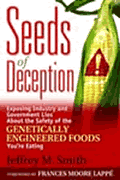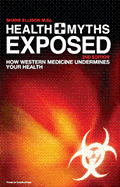Related
Articles:
Cal. County Bans Genetically Modefied Seeds (GMO's)
Hungarians
Protest Agains
GMO Grain
Other
Smith
Articles:
How to Avoid Genetically
Modefied Foods
GENETICALLY ENGINEERED CROPS MAY PRODUCE HERBICIDE INSIDE OUR INTESTINES
By
Jeffrey Smith
June 7, 2006
NewsWithViews.com
Pioneer Hi-Bred�s website boasts that their genetically modified (GM) Liberty Link[1] corn survives doses of Liberty herbicide, which would normally kill corn. The reason, they say, is that the herbicide becomes �inactive in the corn plant.�[2] They fail to reveal, however, that after you eat the GM corn, some inactive herbicide may become reactivated inside your gut and cause a toxic reaction. In addition, a gene that was inserted into the corn might transfer into the DNA of your gut bacteria, producing long-term effects. These are just a couple of the many potential side-effects of GM crops that critics say put the public at risk.
Herbicide tolerance (HT) is one of two basic traits common to nearly all GM crops. About 71% of the crops are engineered to resist herbicide, including Liberty (glufosinate ammonium) and Roundup[3] (glyphosate). About 18% produce their own pesticide. And 11% do both. The four major GM crops are soy, corn, cotton and canola, all of which have approved Liberty- and Roundup-tolerant varieties. Herbicide tolerant (HT) crops are a particularly big money-maker for biotech companies, because when farmers buy HT seeds, they are required to purchase the companies� brand of herbicide as well. In addition, HT crops dramatically increase the use of herbicide,[4] which further contributes to the companies� bottom line.
There are no required safety tests for HT crops in the US�if the biotech companies declare them fit for human consumption, the FDA has no further questions. But many scientists and consumers remain concerned, and the Liberty Link varieties pose unique risks.
Liberty herbicide (also marketed as Basta, Ignite, Rely, Finale and Challenge) can kill a wide variety of plants. It can also kill bacteria,[5] fungi[6] and insects,[7] and has toxic effects on humans and animals.[8] The herbicide is derived from a natural antibiotic, which is produced by two strains of a soil bacterium. In order that the bacteria are not killed by the antibiotic that they themselves create, the strains also produce specialized enzymes which transform the antibiotic to a non-toxic form called NAG (N-acetyl-L-glufosinate). The specialized enzymes are called the pat protein and the bar protein, which are produced by the pat gene and the bar gene, respectively. The two genes are inserted into the DNA of GM crops, where they produce the enzymes in every cell. When the plant is sprayed, Liberty�s solvents and surfactants transport glufosinate ammonium throughout the plant, where the enzymes convert it primarily into NAG. Thus, the GM plant detoxifies the herbicide and lives, while the surrounding weeds die.
The problem is that the NAG, which is not naturally present in plants, remains there and accumulates with every subsequent spray. Thus, when we eat these GM crops, we consume NAG. Once the NAG is inside our digestive system, some of it may be re-transformed back into the toxic herbicide. In rats fed NAG, for example, 10% of it was converted back to glufosinate by the time it was excreted in the feces.[9] Another rat study found a 1% conversion.[10] And with goats, more than one-third of what was excreted had turned into glufosinate.[11]
It is believed that gut bacteria, primarily found in the colon or rectum, are responsible for this re-toxification.[12] Although these parts of the gut do not absorb as many nutrients as other sections, rats fed NAG did show toxic effects. This indicates that the herbicide had been regenerated, was biologically active, and had been assimilated by the rats.[13] A goat study also confirmed that some of the herbicide regenerated from NAG ended up in the kidneys, liver, muscle, fat and milk.[14]
More information about the impact of this conversion is presumably found in �Toxicology and Metabolism Studies� on NAG, submitted to European regulators by AgrEvo (now Bayer CropScience). These unpublished studies were part of the application seeking approval of herbicide-tolerant canola. When the UK government�s Pesticide Safety Directorate attempted to provide some of this information to an independent researcher, they were blocked by the company�s threats of legal action.[15] The studies remained private.
Glufosinate ammonium is structurally similar to a natural amino acid called glutamic acid, which can stimulate the central nervous system and, in excess levels, cause the death of nerve cells in the brain.[16] The common reactions to glufosinate poisoning in humans include unconsciousness, respiratory distress and convulsions. One study also linked the herbicide with a kidney disorder.[17] These reactions typically involve large amounts of the herbicide. It is unclear if the amount converted from GM crops would accumulate to promote such responses or if there are low dose chronic effects.
Perhaps a more critical question may be whether infants or fetuses are impacted with smaller doses. A January 2006 report issued by the Environmental Protection Agency�s (EPA) Office of Inspector General said that studies demonstrate that certain pesticides easily enter the brain of young children and fetuses, and can destroy cells. That same report, however, stated that the EPA lacks standard evaluation protocols for measuring the toxicity of pesticides on developing nervous systems.[18] Scientists at the agency also charged that �risk assessments cannot state with confidence the degree to which any exposure of a fetus, infant or child to a pesticide will or will not adversely affect their neurological development.� [19]Furthermore, three trade unions representing 9,000 EPA workers claimed that the evaluation techniques used at the agency were highly politicized. According to a May 24, 2006 letter to the EPA�s administrator, the unions cited �political pressure exerted by Agency officials perceived to be too closely aligned with the pesticide industry and former EPA officials now representing the pesticide and agricultural community.�[20]
Although the EPA may be hampered in its evaluations, research has nonetheless accumulated which suggests that glufosinate carries significant risks for the next generation. According to Yoichiro Kuroda, the principal investigator in the Japanese project entitled �Effects of Endocrine Disrupters on the Developing Brain,� glufosinate is like a �mock neurotransmitter.� Exposure of a baby or embryo can affect behavior, because the chemical disturbs gene functions that regulate brain development.[21]
When mouse embryos were exposed to glufosinate, it resulted in growth retardation, increased death rates, incomplete development of the forebrain and cleft lips,[22] as well as cell death in part of the brain.[23] After pregnant rats were injected with glufosinate, the number of glutamate receptors in the brains of the offspring appeared to be reduced.[24] When infant rats were exposed to low doses of glufosinate, some of their brain receptors appeared to change as well.[25]
Glufosinate herbicide might also influence behavior. According to Kuroda, �female rats born from mothers that were given high doses of glufosinate became aggressive and started to bite each other�in some cases until one died.� He added, �That report sent a chill through me.�[26]
If the herbicide is regenerated inside our gut, since it is an antibiotic, it will likely kill gut bacteria. Gut microorganisms are crucial for health. They not only provide essential metabolites like certain vitamins and short fatty acids, but also help the break down and absorption of food and protect against pathogens. Disrupting the balance of gut bacteria can cause a wide range of problems. According to molecular geneticist Ricarda Steinbrecher, �the data obtained strongly suggest that the balance of gut bacteria will be affected�[27] by the conversion of NAG to glufosinate.
When eating Liberty Link corn, we not only consume NAG, but also the pat and bar genes with their pat and bar proteins. It is possible that when NAG is converted to herbicide in our gut, the pat protein, for example, might reconvert some of the herbicide back to NAG. This might lower concentrations of glufosinate inside of our gut. On the other hand, some microorganisms may be able to convert in both directions, from glufosinate to NAG and also back again. If the pat protein can do this, that is, if it can transform NAG to herbicide, than the presence of the pat protein inside our gut might regenerate more herbicide from the ingested NAG. Since there are no public studies on this, we do not know if consuming the pat gene or bar genes will make the situation better or worse.
But one study on the pat gene raises all sorts of red flags. German scientist Hans-Heinrich Kaatz demonstrated that the pat gene can transfer into the DNA of gut bacteria. He found his evidence in young bees that had been fed pollen from glufosinate-tolerant canola plants. The pat gene transferred into the bacteria and yeast inside the bees� intestines. Kaatz said, �This happened rarely, but it did happen.�[28] Although no studies have looked at whether pat genes end up in human gut bacteria, the only human GM-feeding study ever conducted did show that genetic material can transfer to our gut bacteria. This study, published in 2004, confirmed that portions of the Roundup-tolerant gene in soybeans transferred to microorganisms within the human digestive tract.[29]
Since the pat gene can transfer to gut bacteria in bees, and since genetic material from another GM crop can transfer to human gut bacteria, it is likely that the pat gene can also transfer from Liberty Link corn or soybeans to our intestinal flora. If so, a key question is whether the presence of the pat gene confers some sort of survival advantage to the bacteria. If so, �selection pressure� would favor its long term proliferation in the gut.
Because the pat protein can protect bacteria from being killed by glufosinate, gut bacteria that take up the gene appears to have a significant survival advantage. Thus, the gene may spread from bacteria to bacteria, and might stick around inside us for the long-term. With more pat genes, more and more pat protein is created. The effects of long-term exposure to this protein have not been evaluated.
Now suppose that the pat protein can also re-toxify NAG back into active herbicide, as discussed above. A dangerous feedback loop may be created: We eat Liberty Link corn or soy. Our gut bacteria, plus the pat protein, turns NAG into herbicide. With more herbicide, more bacteria are killed. This increases the survival advantage for bacteria that contain the pat gene. As a consequence, more bacteria end up with the gene. Then, more pat protein is produced, which converts more NAG into herbicide, which threatens more bacteria, which creates more selection pressure, and so on. Since studies have not been done to see if such a cycle is occurring, we can only speculate.
Endocrine disruption at extremely low doses
Another potential danger from the glufosinate-tolerant crops is the potential for endocrine disruption. Recent studies reveal that endocrine-disrupting chemicals (EDCs) can have significant hormonal effects at doses far below those previously thought to be significant. The disruptive effects are often found only at minute levels, which are measured in parts per trillion or in the low parts per billion. This is seen, for example, in the way estrogen works in women. When the brain encounters a mere 3 parts per trillion, it shuts down production of key hormones. When estrogen concentration reaches 10 parts per trillion, however, there is a hormone surge, followed by ovulation.
Unfortunately, the regulation and testing of agricultural chemicals, including herbicides, has lagged behind these findings of extremely low dose effects. The determination of legally acceptable levels of herbicide residues on food was based on a linear model, where the effect of toxic chemicals was thought to be consistent and proportional with its dosage. But as the paper Large Effects from Small Exposures shows, this model underestimates biological effects of EDCs by as much as 10,000 fold.[30]
In anticipation of their (not-yet-commercialized) Liberty Link rice, Bayer CropScience successfully petitioned the EPA in 2003 to approve maximum threshold levels of glufosinate ammonium on rice. During the comment period preceding approval, a Sierra Club submittal stated the following.
�We find EPA�s statements on the potential of glufosinate to function as an endocrine-disrupting substance in humans and animals as not founded on logical information or peer-reviewed studies. In fact EPA states that no special studies have been conducted to investigate the potential of glufosinate ammonium to induce estrogenic or other endocrine effects. . . . We feel it�s totally premature for EPA at this time to dismiss all concerns about glufosinate as an endocrine-disrupting substance. . . . Due to the millions of Americans and their children exposed to glufosinate and its metabolites, EPA needs to conclusively determine if this herbicide has endocrine-disrupting potential.�
The EPA�s response was that �glufosinate ammonium may be subjected to additional screening and/or testing to better characterize effects related to endocrine disruption�[31] but this will only take place after these protocols are developed. In the mean time, the agency approved glufosinate ammonium residues on rice at 1 part per million.
Since glufosinate ammonium might have endocrine disrupting properties, even small conversions of NAG to herbicide may carry significant health risks for ourselves and our children.
If we look to animal feeding studies to find out if Liberty Link corn creates health effects, we encounter what independent observers have expressed for years�frustration. Industry-sponsored safety studies, which are rarely published and often kept secret, are often described as designed to avoid finding problems.
In a 42-day feeding study on chickens, for example, 10 chickens (7%) fed Liberty Link corn died compared to 5 chickens eating natural corn.[32] Even with the death rate doubled, �because the experimental design was so flawed,� said bio-physicist Mae-Wan Ho, �statistical analysis failed to detect a significant difference between the two groups.�[33] Similarly, although the GM-fed group gained less weight, the study failed to recognize that as significant. According to testimony by two experts in chicken feeding studies,[34] the Liberty Link corn study wouldn�t identify something as significant unless there had been �huge� changes. The experts said, �It may be worth noting, in passing, that if one were seeking to show no effect, one of the best methods to do this is would be to use insufficient replication, a small n,�[35] which is exactly the case in the chicken study.
|
Subscribe to the NewsWithViews Daily News Alerts! |
Without
adequate tests and with a rubber stamp approval process, GM crops
like Liberty Link corn may already be creating significant hard-to-detect
health problems. In Europe, Japan, Korea, Russia, China, India, Brazil
and elsewhere, shoppers have the benefit of laws that require foods
with GM ingredients to be labeled. In the US, however, consumers wishing
to avoid them are forced to eliminate all products containing soy
and corn, as well as canola and cottonseed oils. Or they can buy products
that are organic or say �non-GMO� on the package. Changing one�s diet
is a hassle, but with the hidden surprises inside GM foods, it may
be a prudent option for health-conscious people, especially young
children and pregnant women.
Footnotes:
1,
Liberty Link is a registered trademark of Bayer CropScience
2,
Pioneer
Brand hybrids with the LibertyLink1 gene
3,
Roundup is a registered trademark of Monsanto
4,
Charles Benbrook, "Genetically
Engineered Crops and Pesticide Use in the United States: The First
Nine Years," October 2004
5,
Colanduoni JA and Villafranca JJ (1986). Inhibition of Escherichia
coli glutamine-synthetase by phosphinothricin. Bioorganic Chemistry
14(2): 163-169, and Pline W A~ Lacy GH~ Stromberg V ~ Hatzios KK (200
I). Antibacterial activity of the herbicide glufosinate on Pseudomonas
syringae pathovar glycinea. Pesticide Biochemistry And Physiology
71(1): 48-55.
6,
Liu CA; Zhong H; Vargas J; Penner D; Sticklen M (1998). Prevention
of fungal diseases in transgenic, bialaphos- and glufosinate-resistant
creeping bentgrass (Agrostis palustrls). Weed Science 46(1): 139-146,
and Tada T~ Kanzaki H~ Norita E~ Uchimiya H~ Nakamura I (1998). Decreased
symptoms of rice blast disease on leaves of bar-expressing transgenic
rice plants following treatment with bialaphos. Molecular Plant-Microbe
Interactions 9(8): 762-764.
7,
Ahn Y -J, Kim Y -J and Yoo J-K (2001). Toxicity of the herbicide glufosinate-ammonium
to predatory insects and mites of Tetranychus urticae (Acari: Tetranychidae)
under laboratory conditions. Journal Of Economic Entomology 94(1):
s157-161.
8,
Watanabe T and Sano T (1998). Neurological effects of glufosinate
poisoning with a brief review. Human & Experimental Toxicology 17(1):
35-39.
9,
Bremmer IN and Leist K-H (1997). Disodium-N-acetyl-L-glufosinate;
AE F099730 - Hazard evaluation of Lglufosinate produced intestinally
from N-acetyl-L-glufosinate. Hoechst Schering AgrEvo GmbH, Safety
Evaluation Frankfurt. TOX97/014. A58659. Unpublished.
10,
Kellner H-M, StumpfK and Braun R (1993). Hoe 099730-14C Pharmacokinetics
in rats following single oral and intravenous administration of3 mg/kg
body. Hoechst RCL, Germany, 01-L420670-93. A49978. Unpublished.
11,
Huang, M.N. and Smith, S.M. 1995b. Metabolism
of [14C]-N-acetyl glufosinate in a lactating goat. AgrEvo USA
Co.Pikeville, PTRL East Inc., USA. Project 502BK. Study U012A/A524.
Report A54155. Unpublished.
12,
In one study, for example, protein produced from a gene found in E.
coli turned NAG into glufosinate. G. Kriete et al, Male sterility
in transgenic tobacco plants induced by tapetum-specific deacetylation
of the externally applied non-toxic compound N-acetyl-L-phosphinothricin,
Plant Journal, 1996, Vol.9, No.6, pp.809-818.
13,
Bremmer IN and Leist K-H (1998). Disodium-N-acetyl-L-glufosinate (AE
F099730, substance technical) - Toxicity
and metabolism studies summary and evaluation. Hoechst Schering
AgrEvo, Frankfurt. TOX98/027. A67420. Unpublished. (see FAO publication
on
14,
Huang, M.N. and Smith, S.M. 1995b. Metabolism
of [14C]-N-acetyl glufosinate in a lactating goat. AgrEvo USA
Co.Pikeville, PTRL East Inc., USA. Project 502BK. Study U012A/A524.
Report A54155. Unpublished.
15,
Ricarda A. Steinbrecher, Risks associated with ingestion of Chardon
LL maize, The reversal of N-acetyl-L- glufosinate to the active herbicide
L-glufosinate in the gut of animals, Chardon LL Hearing, May 2002,
London. (Note: This work is an excellent summary of the risks associated
with NAG conversion within the gut.)
16,
Fujii, T., Transgenerational effects of maternal exposure to chemicals
on the functional development of the brain in the offspring. Cancer
Causes and Control, 1997, Vol. 8, No. 3, pp. 524-528.
17,
H. Takahashi et al., "A Case of Transient
Diabetes Isipidus Associated with Poisoning by a Herbicide Containing
Glufosinate." Clinical Toxicology 38(2), 2000, pp.153-156
18,
Ohn J. Fialka, EPA
Scientists Pressured to Allow Continued Use of Dangerous Pesticides,
Wall Street Journal Page A4, May 25, 2006
19,
EPA SCIENTISTS
PROTEST PENDING PESTICIDE APPROVALS; Unacceptable Risk to Children
and Political Pressure on Scientists Decried, Press release, Public
Employees for Environmental Responsibility. May 25, 2006,
20,
EPA
SCIENTISTS PROTEST PENDING PESTICIDE APPROVALS; Unacceptable Risk
to Children and Political Pressure on Scientists Decried, Press release,
Public Employees for Environmental Responsibility. May 25, 2006,
21,
Bayer's GE Crop Herbicide, Glufosinate, Causes Brain Damage, The Japan
Times, 7 December 2004
22,
Watanabe, T. and T. Iwase, Development and dymorphogenic effects of
glufosinate ammonium on mouse embryos in culture. Teratogenesis carcinogenesis
and mutagenesis, 1996, Vol. 16, No. 6, pp. 287-299.
23,
Watanabe, T. , Apoptosis induced by glufosinate ammonium in the neuroepithelium
of developing mouse embryos in culture. Neuroscientific Letters, 1997,
Vol. 222, No. 1, pp.17-20, as cited in Glufosinate ammonium fact sheet,
Pesticides News No.42, December 1998, p 20-21.
24,
Fujii, T., Transgenerational effects of maternal exposure to chemicals
on the functional development of the brain in the offspring. Cancer
Causes and Control, 1997, Vol. 8, No. 3, pp. 524-528.
25,
Fujii,
T., T. Ohata, M. Horinaka, Alternations in the response to kainic
acid in rats exposed to glufosinate-ammonium, a herbicide, during
infantile period. Proc. Of the Japan Acad. Series B-Physical and Biological
Sciences, 1996, Vol. 72, No. 1, pp. 7-10.
26,
Bayer's GE Crop Herbicide, Glufosinate, Causes Brain Damage, The Japan
Times, 7 December 2004
27,
Ricarda A. Steinbrecher, Risks associated
with ingestion of Chardon LL maize, The reversal of N-acetyl-L- glufosinate
to the active herbicide L-glufosinate in the gut of animals, Chardon
LL Hearing, May 2002, London. (Note: This work is an excellent summary
of the risks associated with NAG conversion within the gut.)
28, Antony Barnett, New Research Shows Genetically Modified
Genes Are Jumping Species Barrier, London Observer, May 28, 2000.
29, Netherwood, et al, Assessing the survival of transgenic
plant DNA in the human gastrointestinal tract, Nature Biotechnology,
Vol 22 Number 2 February 2004.
30, Wade V. Welshons et al, Large Effects from Small Exposures.
I. Mechanisms for Endocrine-Disrupting Chemicals with Estrogenic Activity,
Table 2,Environmental Health Perspectives Volume 111, Number 8, June
2003.
31, Glufosinate
Ammonium; Pesticide Tolerance, Environmental Protection Agency, Federal
Register: September 29, 2003 (Volume 68, Number 188), 40 CFR Part
180, ACTION: Final rule
32, S. Leeson, The effect of Glufosinate Resistant Corn on
Growth of Male Broiler Chickens, by Department of
33, Mae-Wan Ho, Exposed: More
Shoddy Science in GM Maize Approval, ISIS Press Release 13/03/04
34, Testimony of Steve Kestin and Toby Knowles, Department
of Clinical Veterinary Science, University of Bristol on behalf of
Friends of the Earth, before the Chardon LL Hearings of the Advisory
Committee on Releases to the Environment, November 2000.
35, Testimony of Steve Kestin and Toby Knowles, Department
of Clinical Veterinary Science, University of Bristol on behalf of
Friends of the Earth, before the Chardon LL Hearings of the Advisory
Committee on Releases to the Environment, November 2000.
� 2006 Jeffrey M. Smith- All Rights Reserved
Sign Up For Free E-Mail Alerts
E-Mails are used strictly for NWVs alerts, not for sale
Jeffrey M. Smith is working with a team of international scientists to catalog all known health risks of GM foods. He is the author of Seeds of Deception, the world's bestselling book on GM food, and the producer of the video, Hidden Dangers in Kids' Meals.
Website: www.seedsofdeception.com
E:Mail: info@seedsofdeception.com
There are no required safety tests for HT crops in the US�if the biotech
companies declare them fit for human consumption, the FDA has no further
questions. But many scientists and consumers remain concerned, and the
Liberty Link varieties pose unique risks.









